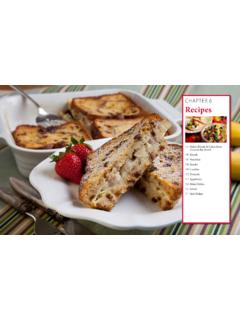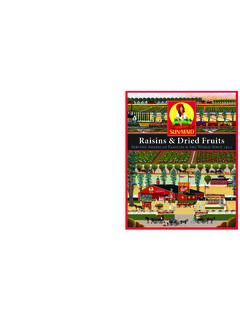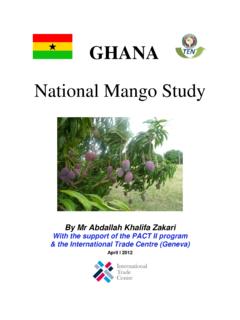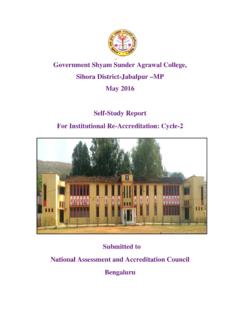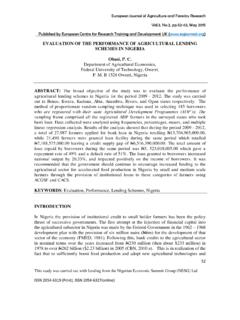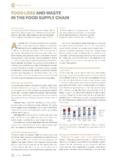Transcription of Science Base to Support the Antimicrobial Action of Raisins
1 Center for Chemical Regulation and Food Safety Science Base to Support the Antimicrobial Action of Raisins N0T0 0909 BE24 Science Base to Support the Antimicrobial Action of Raisins Prepared for: Barry Kriebel Sun-Maid Growers 13525 South Bethel Avenue Kingsburg, California 93631-9232 Prepared by: Brian Shawn Eblen, MS. Exponent, Inc. 17000 Science Drive, Suite 200 Bowie, MD 20715 September 30, 2009 Exponent, Inc. ii N0T0 0909 BE24 Contents Page List of Tables iii Acronyms and Abbreviations iv Executive Summary v 1 Objectives 1 2 Resources 2 3 Introduction 3 4 Scientific Observations of the Antimicrobial Action of Raisins 4 Publically Available Studies 4 Human Pathogen Challenge Studies 6 Antimicrobial Activity of Raisins 8 Intact Raisins vs. Raisin Products 8 Antimicrobial Action Occurs as a Function of Exposure Time 8 Effect of Neutralizing pH and aw on Pathogen Reduction 8 Effect of Processing and Storage Temperature 9 Effect of Variety and Agricultural Practices 9 Rate of Inactivation 9 5 Potential Antimicrobial Mechanisms 11 Acidity and Water Activity 11 Intrinsic Compounds 12 Phenolics 12 Maillard Non-enzymatic Browning Products 14 Location of Antimicrobial Compounds within the Raisin 14 6 Intrinsic Properties and Interactions 15 7 Summary 16 8 Literature Cited 18 9 Biographies 20 iii N0T0 0909 BE24 List of Tables Page Table 1.
2 Search terms used for literature searches on AGRICOLA and PubMed databases 2 Table 2. Antimicrobial activity of raisin components 5 Table 3. Summary of pathogen challenge study results 7 Table 4. Minimum pH and water activity growth values for selected bacterial pathogens 11 Table 5. Potential Antimicrobial compounds identified in Raisins 13 iv N0T0 0909 BE24 Acronyms and Abbreviations AIB American Institute of Baking aw Water activity DOV Dried-on-the-vine FSNS Food Safety Net Services NFL National Food Laboratory MRP Maillard non-enzymatic browning Reaction Products pH Measurement of acidity. Technically, the negative logarithm of the hydrogen ion concentration in an aqueous solution USDA United States Department of Agriculture v N0T0 0909 BE24 Executive Summary Exponent, Inc.
3 (Exponent) was retained by Sun-Maid Growers (Sun-Maid) to prepare a report summarizing all known scientific studies that demonstrate the bacterial inhibition potential of Raisins , as well as the current understanding of the mechanisms responsible for this Action . Exponent reviewed publically available reports of the Antimicrobial activity of Raisins and unpublished studies. The challenge testing sponsored by Sun-Maid Growers, other studies on Raisins , and knowledge about specific chemical inhibitors present in Raisins , all point to an inhospitable microbiological environment for their growth or survival. Pathogenic microorganisms not only are incapable of growth, they die over a relatively short storage period of days to weeks. A summary of Exponent s conclusions include: Raisins have an unsurpassed food safety record, with no reported foodborne illness attributed to their consumption; Raisins and raisin components exhibit marked Antimicrobial activity against spoilage organisms and human pathogens; Raisin products and extracts can impart Antimicrobial properties into some food products at levels that do not significantly affect sensory characteristics; Differences in field drying and growing practices did not significantly affect the Antimicrobial properties of the Raisins ; Microbial growth is prevented by the combination of acidity, low water activity, and inhibitory compounds.
4 This unfavorable environment promotes the relatively rapid decrease in microbial numbers during storage; The rate of pathogen inactivation would eliminate likely levels of contamination prior to the product reaching consumers; Preliminary studies suggest that Antimicrobial chemicals within Raisins are responsible for a significant amount of the inactivation observed, however, the interaction between phenolic compounds and pH on inactivation is unknown; vi N0T0 0909 BE24 Phenolic compounds identified in Raisins exhibit Antimicrobial properties at or below levels that are present in Raisins ; and More research is needed to determine the Antimicrobial mechanisms of Action , specifically, o Compounds and their location within the raisin responsible for the majority of the Antimicrobial activity, and o The relative contribution, including potential synergistic activity, of the intrinsic Antimicrobial factors in Raisins .
5 1 N0T0 0909 BE24 1 Objectives Exponent, Inc. (Exponent) was retained by Sun-Maid Growers (Sun-Maid) to prepare a report to serve as the scientific basis to promote to industrial customers and the consuming public the inherent Antimicrobial activity of Raisins and raisin products. Exponent has summarized all known scientific studies that demonstrate the bacterial inhibition potential of Raisins , as well as the current understanding of the mechanisms responsible for this Action . 2 N0T0 0909 BE24 2 Resources Exponent reviewed published reports, using PubMed and AGRICOLA databases (Table 1), of the Antimicrobial activity of: Raisins , compounds associated with Raisins , other dried fruit, and fresh fruit or berries. Exponent also updated a previous literature search of foodborne illnesses attributed to Raisins using AGRICOLA and PubMed databases.
6 Table 1. Search terms used for literature searches on AGRICOLA and PubMed databases Commodity Additional Search Term Fruit Antibacterial Berry Antifungal Almond Antimicrobial Apple Bacteria Apricot Dried Cherry (cherr*) Escherichia coli Cranberry (cranberr*) Fungal Currant Inhibition Dates Intestinal pathogen Fig Pathogen Mango Preservative Papaya Salmonella Peach Spoilage Pear Pineapple Plum Prune Raisin 3 N0T0 0909 BE24 3 Introduction Dried fruit consumption has benefited human kind for thousands of years, providing a safe and healthy source of nutrients. This food class is produced in most geographic regions of the world and consumption occurs by all cultures and demographic segments. Certainly, the long and widespread enjoyment of dried fruit contributes to its reputation as a safe and wholesome food.
7 This was supported by a 2006 literature review performed by Exponent, which determined that there were no reports of infectious foodborne illness linked to dried fruit. Exponent updated that literature search for this assignment and confirmed our previous findings. Raisins have never been implicated with foodborne illness, suggesting that the following extrinsic or intrinsic factor(s) may impart Antimicrobial protection. First, hot desert temperatures may directly kill microorganisms that are in the general environment. Second, the cessation of irrigation prior to harvest promotes drying of the grapes, which starts water activity (aw) reduction. Drying continues once clusters are cut and placed on Kraft paper, which has ground temperatures of up to 60C or 140F. Third, natural acidity may also contribute to the inactivation of microorganisms.
8 Finally, drying concentrates and changes the chemical composition of Raisins , forming compounds inhibitory to the growth and survival of pathogenic microorganisms, especially bacteria. In the following sections of this report, Exponent summarizes scientific observations of the microbial inhibitory activity of Raisins and raisin products and current understanding of the potential Antimicrobial mechanisms. 4 N0T0 0909 BE24 4 Scientific Observations of the Antimicrobial Action of Raisins Exponent reviewed research studies that investigated the Antimicrobial potential of Raisins and raisin products, which are contained in the following sections: Publically Available Studies Only three peer-reviewed, published studies were found which evaluated the Antimicrobial activity of Raisins , raisin extracts, raisin paste, or raisin juice concentrate.
9 Exponent also identified one thesis, which demonstrated the potential use of Raisins as a food preservative (Wei, 2006). Finally, American Institute of Baking (AIB) released a technical bulletin on this topic (Ziemke, 1980). Table 2 summarizes those findings. 5 N0T0 0909 BE24 Table 2. Antimicrobial activity of raisin components Raisin Constituent Observation Citation Action Microorganism(s) Raisin extracts and raisin puree 15% added to beef jerky inactivated pathogens without adverse sensory effects. Staphylococcus aureus, Listeria monocytogenes and E. coli O157:H7 Bower et al., 2003 Soluble partition of a raisin methanol extract Extracts inhibited bacterial growth. Streptococcus mutans and Porphyromonas gingivalis Fausto Rivero-Cruz et al., 2008 Water and 60% ethanol extracts of Raisins , raisin paste, raisin fiber, and raisin juice concentrate Extracts inactivated mold and bacteria species in liquid and conventional bread systems, increasing shelf life without adverse sensory effects.
10 Bacillus spp, and Aspergillus and Penecillium spp. Wei et al., 2009 Ethanol and water extracts of raisin Extracts inhibited bacteria and fungi in liquid bread systems. Bacillus spp, Aspergillus spp. Wei, 2006 Crushed Raisins and raisin juice concentrate 12-17% crushed Raisins and 13% concentrate slowed mold growth on bread and extended shelf life without adverse sensory effects. Unidentified mold species Ziemke, 1980 6 N0T0 0909 BE24 Two generalizations can be made from the findings of the publically available literature. First, taken together, the information strongly suggests that raisin components exhibit Antimicrobial Action against spoilage organisms and human pathogens (Table 2). Second, raisin products and extracts exhibited Antimicrobial properties in food at levels that did not significantly affect sensory characteristics (Bower et al.)
